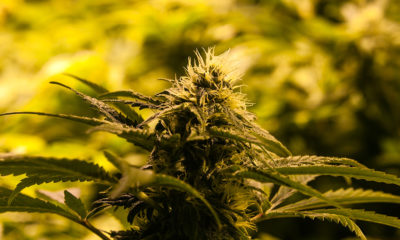
Medical
George McMahon, Who Got Medical Pot from the Feds for Decades, Passes Away
McMahon was one of a handful of patients who received free medical marijuana through a federal program established in 1978. The program shuttered to new patients in 1992, but McMahon received federal pot until his death.
Medical marijuana patient, author and pioneering activist George McMahon passed away on Nov. 30 at the age of 69. McMahon’s passing in Iowa was first reported by family members on Facebook and then on Wisconsin cannabis news site CannaBadger.
McMahon was one of only three remaining patients who receive cannabis under a unique program from the FDA called the Investigational New Drug Program (IND). The government usually grants severely ill people IND access to use experimental pharmaceutical drugs not yet FDA approved, but in 1978, a lawsuit from activist Robert Randall forced the IND program to allow legal access to cannabis. So, for decades, the federal government sent qualifying patients — a group that peaked at 15 participants in the early 1990s — as many as 300 joints a month, grown on the National Institute on Drug Abuse’s farm at the University of Mississippi.
McMahon’s participation in the groundbreaking program came as a result of being diagnosed with nail-patella syndrome, which is characterized by abnormalities of the nails, knees, elbows and pelvis. The features of nail-patella syndrome vary in severity between affected individuals, even among members of the same family.
In 2006, McMahon spoke at the National Clinical Conference on Cannabis Therapeutics in Santa Barbara, California about his experiences with medical marijuana and how it changed his life for the better.
“The first medical joint [I got from the federal government] was in 1988,” McMahon told the crowd. “I got it from a health worker.”
He said, until that point, his life had been a turnstile of attempts to treat his condition. He claimed what was really wrong him was all the other medications he was forced to endure before finding out that marijuana could be effective in treating his condition.
His doctor at the time was the one who got McMahon successfully enrolled in the IND, but at the time, there was a two-year application process where he was told he would have to abstain from using his newfound miracle medicine in order to qualify.
“[The doctor] sees me get better and the government has the nerve to say to him, the medicine man, ‘You need me, the lawyer, to tell you how to treat him,’” McMahon said. After six months of abstinence from pot, he was back to taking 17 pills a day.
When he eventually got the first batch of medical marijuana from the government on a Friday night, he says he woke up on Saturday and flushed all of those pills down the toilet.
McMahon said his diagnosis was really for pain, spasms and nausea.
“You don’t have to be somebody special, not one of us they can define, you just got to have some of those symptoms,” McMahon told the crowd. “And that really makes me feel good. That pretty much means I’m right, that it’s right for everybody.”
In 2002, researchers looked at the impact the IND cannabis program had on the health of four of the surviving participants. They wrote: “Results demonstrate clinical effectiveness in these patients in treating glaucoma, chronic musculoskeletal pain, spasm and nausea, and spasticity of multiple sclerosis. All four patients are stable with respect to their chronic conditions, and are taking many fewer standard pharmaceuticals than previously.”
NORML founder Keith Stroup told Cannabis Now that the IND program gave a huge boost of credibility to the burgeoning medical marijuana movement in the 1970s.
“The Investigative New Drug program that ended up authorizing more than 30 patients to use medical marijuana (supplied by the government) before it was eventually shut down, was terribly important at the time, as medical marijuana had not yet been approved by any state (California was first in 1996) and was officially denied as a medicine by the federal government,” he said in an email. “The fact that this handful of trailblazers were permitted to use medical marijuana as part of a scientific investigation, although there is no evidence the government actually studied the effectiveness of the medical marijuana, gave enormous support and credibility to the medical use movement.”
Of course, Stroup noted the irony of the federal government giving out cannabis as medicine while the Controlled Substances Act stated cannabis had no medical benefit.
“It also underscored the ‘head-in-the-sand’ federal policy that could on one hand ship 300 marijuana joints monthly to patients in the IND program while at the same time denying that marijuana had any legitimate medical uses,” Stroup wrote.
Stroup went on to say it is also important to note why the IND program stopped accepting new patients in 1992. He said that President George H.W. Bush was shocked at the large number of HIV/AIDS patients who were suddenly applying for admission to the IND program, and suddenly closed the entire program from accepting new patients in 1992.
Stroup believes Bush chose to close the program rather than allow it to be composed of mostly gay patients.
“He did, surprisingly, continue the program for those who had already been admitted, and the program is still providing pre-rolled joins to the two remaining patients in the program,” Stroup said.
The program’s two surviving patients, Irv Rosenfeld and Elvy Musikka, continue to be active in the medical marijuana movement.
Stroup went on to note that the IND program was crucial for making medical cannabis widely available around the country — a fight which McMahon spent decades working on.
“Once California voters legalized the medical use of marijuana in 1996, the medical use movement was off and running and the original IND program was a footnote in history,” Stroup said. “But the victory in California in ’96 might not have been possible but for the legitimacy and public acceptance medical use had gained because of the publicity surrounding the IND program.”
TELL US, what will you do to support medical marijuana patients?

























